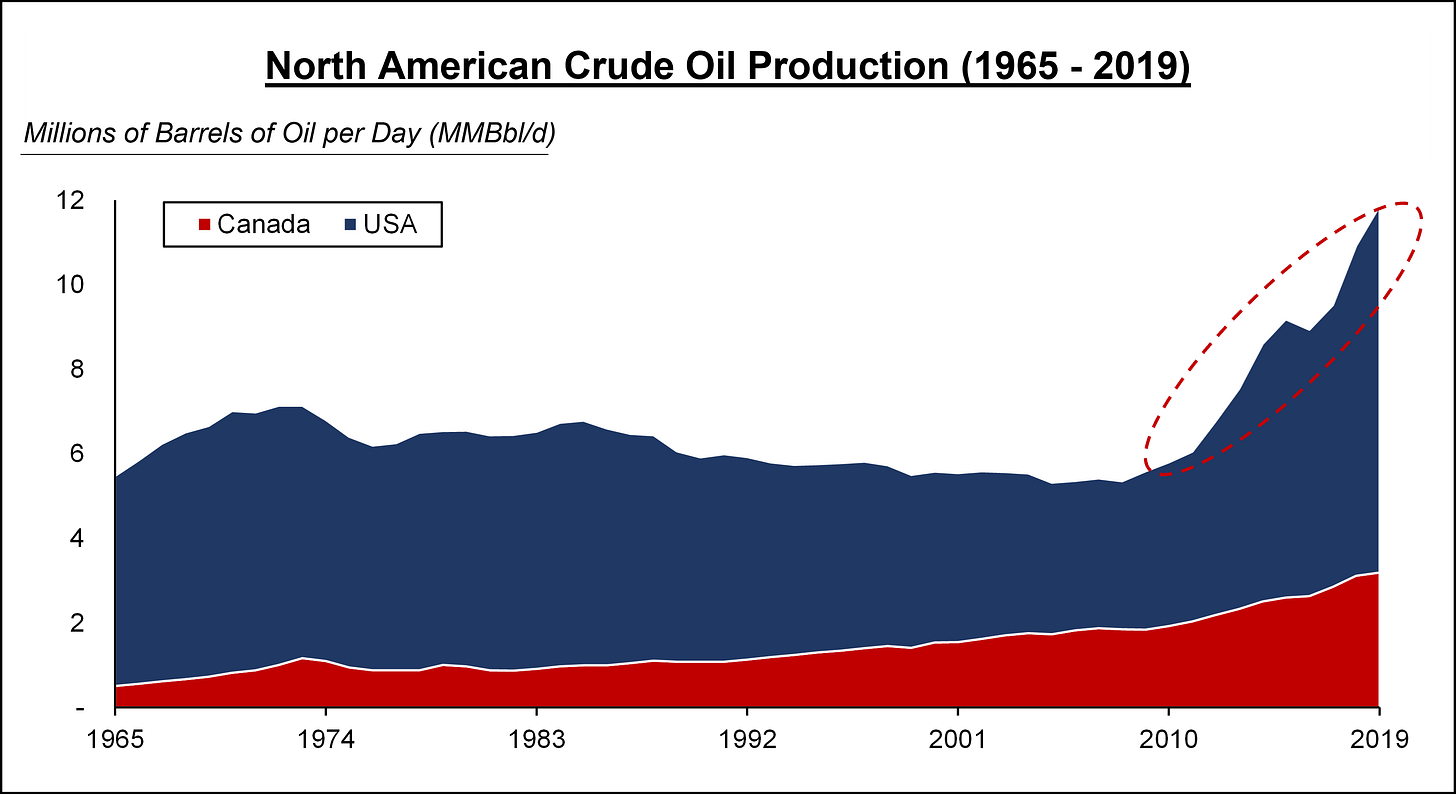Welcome to those who recently joined us. If you aren’t yet subscribed to the Plug, the link below will help solve that problem. 👇
Today, with our glasses half-full, we’re going to look at North American oil production.
Despite the rhetoric of armchair environmentalists and media organizations, domestic oil production isn’t all bad. In reality, a world without North American oil production is unlikely to resemble the utopian future that’s painted as an inevitability.
To explore the benefits of oil production in North America, we're going to look at:
The current state of North American oil demand. 🛢️
Where the global oil supply currently comes from. 💵
Defining energy security, and why is it important. 💪
The Flip Side of North American Oil 🌎
Let's kick this off by rehashing the popular talking points:
Generating energy using fossil fuels has negative implications.
Oil, as well as natural gas and coal, are all fossil fuels.
One consequence of consuming oil is that it produces CO2 emissions.
.
We already knew all of that though, right?
In any conversation involving energy consumption, the related environmental impact is unequivocally important. For that reason, I can understand many of the arguments made against North American oil production.
But I’m not here to beat a dead horse.
I believe that lately, the critics of Canadian and American oil production have drowned out other perspectives. And so, the public debate around domestic oil production is overwhelmingly one-sided.
We do, however, reap some benefits from domestic oil production. And those benefits are infrequently discussed. They’re even more poorly understood.
Last week, as conversations between members of the Organization of Petroleum Exporting Countries (OPEC), reverberated through global oil markets, the implications of reducing our domestic oil production became increasingly self-evident.
Our Addiction to Black Gold 🛢️
Here in North America, the chorus of criticism directed at fossil fuels grows louder by the day.
But that narrative doesn't really jive with the reality: we are addicted to crude oil.
Oil remains the largest source of primary energy in North America. In the U.S. and in Canada, oil made up ~37% and ~31% of the energy consumed in 2019, respectively.
Our reliance on oil is a function of three factors:
It's price competitive relative to the other options we have.
It’s abundant in large quantities in both Canada and the U.S.
It’s one of the most reliable generators of energy we have.
.
These three qualities make oil both unique, and hard to replace. For those reasons, oil will remain a bedrock in our energy systems for decades to come.
And, potentially, even longer.

Any realistic forecast of North American energy consumption illustrates that oil will continue to be a staple in our energy mix for the foreseeable future.
That point is proven out by our transportation system. Transportation serves as a fantastic example of how deeply oil is embedded in our D.N.A.
Oil Is In The Driver's Seat
For over a century, crude oil has been the lynchpin of North America's transportation infrastructure. In 2018, transportation accounted for ~60% of Canadian oil demand.
We need to look no further than the cars in our driveways to appreciate that reality.
Most vehicles on the road today are fitted with gasoline-burning engines. And electric vehicles? Well, as we covered last week, they're just starting to gain traction and have their own set of challenges to address.
Most passenger vehicles have a useful life of 13-17 years. That stat, hopefully, gives you a sense of how long it will take to turn over our existing vehicle fleet with cars and trucks that don't burn gasoline.
And beyond passenger transport, the reality is even bleaker.
All of our heavy trucks, planes, and boats remain more reliant on oil than cars and light trucks. And, unlike cars and light trucks, there are currently few viable alternatives to replace oil.
The Implications
If you’ve taken away one thing from this editorial so far, I hope it’s a more informed understanding of how embedded oil is in our society.
Our continued thirst for oil is inevitable. But the source of that oil? Well, that’s a bit less clear.
I can tell you for damn sure that our cars don't care where the oil in our gas tanks comes from.
But we should.
The Cartel Squabbles Over Supply 💵
So, where does OPEC fit into this puzzle?
Oil prices see-sawed last week, as the United Arab Emirates and Saudi Arabia argued over go-forward production quotas.
While this spat was entertaining, it was also inconsequential in the context of OPEC’s role in global oil markets.
A Brief Sidebar on OPEC+
Thirteen member countries make up OPEC - an organization that has been around since the 1960s. Its constituents currently include Saudi Arabia, the United Arab Emirates, Iraq, Venezuela, and Iran.
More recently, in 2016, a handful of other countries agreed to start collaborating with OPEC. Their goal: to further control the global supply of oil. Two notable additions to that alliance are Russia and Mexico.
That larger group of 23 countries is referred to as OPEC+.

Some Reference Points on Oil Global Production
To frame the influence of OPEC+, here are some stats on global oil production lifted from BP’s Statistical Review of World Energy (2020):
Globally in 2019, ~95 million barrels of oil were produced every day (these production figures are referred to as MMBbl/d)
OPEC’s 13 members produced ~35 MMBbl/d (~37% of total)
The 10 other OPEC+ members produced ~18 MMBbl/d (~19% of total)
Canada and the U.S. produced ~23 MMBbl/d (~24% of total)
.
In 2019, the members of OPEC+ produced ~56% of oil, globally.
As a result, the decisions (or indecisions) made by the oil cartel have an outsized impact on global oil markets. In turn, this impacts global access to oil supply.
Consequently, this dynamic shows up in the cost we bear as consumers of oil…
Why North America Should Take Note
The volatility in oil prices seen last week is evidence of OPEC+’s influence. And we should be wary about the cartel's stranglehold on the global oil supply.
There is, however, one obvious way to reduce our reliance on foreign oil production. That is by producing oil domestically.
Over the past two decades, the volume of oil produced in North America exploded. Thanks in large part to American shale oil, which allowed the U.S. to significantly boost its domestic oil production. Canada also significantly increased production in that time frame.
In turn, North America decreased its reliance on foreign oil supply.

Going forward, if policy and activism continue to discourage North American oil producers from drilling for oil, what should we be expecting?
I’d bet that we will need to increase our imports of foreign oil.
There are consequences to villainizing North American oil production. One of which is that, if we reduce North American oil production more quickly than we reduce our oil consumption, we will need to import more oil.
The last time I checked, I didn’t think that bolstering the domestic oil industry of Russia or Saudi Arabia was our goal.
But maybe I’m wrong.

The Financial Times projects that through 2050, OPEC’s market share in global oil markets will rise steadily.
Given the headwinds faced by North American oil producers, this makes logical sense.
But Will It Accelerate Our Clean Energy Transition?
It is noteworthy that villainizing fossil fuels may help to accelerate a transition away from oil, gas and coal.
It’s simple economics really: reducing supply amidst constant demand would serve to drive up oil prices. And high prices serve as a signal for consumers to switch their energy consumption habits.
But our near-term dependence on oil will go unchanged.
Instead, by importing more oil from abroad, we will increase the influence of other countries. While boosting their oil-related tax revenue.
For some of those countries, we may not want to be reliant.
Producing oil domestically provides Canada and the U.S. with independence from foreign influence. More specifically, it provides us with energy security.
OPEC+ Is Coming For Global Oil Production 💪
So, we can continue to make an enemy out of North American oil producers. But we still need oil. And maybe, just maybe, producing oil domestically is a better option than relying on foreign supply.
On the other hand, if policy and activism continue to discourage our domestic oil industry, then we should expect our oil imports to rise.
Thinking About Second-Order Effects
All that to say, there are two sides to every coin, including that of North American oil production.
But that’s not to say that reducing our carbon footprint isn’t also important.
Decreasing our reliance on oil, and other fossil fuels will play a role in that battle. But it's equally important to think about the second-order effects of our actions.
In forcing North America’s transition away from oil, we are also abdicating our energy independence to other oil-producing countries.
Because in the near term, crude oil will remain our economy’s drug of choice.
It may seem like the outcome of reducing North American oil production is unambiguously clear. But let the record state that there will also be unintended consequences that should be considered, and discussed.





